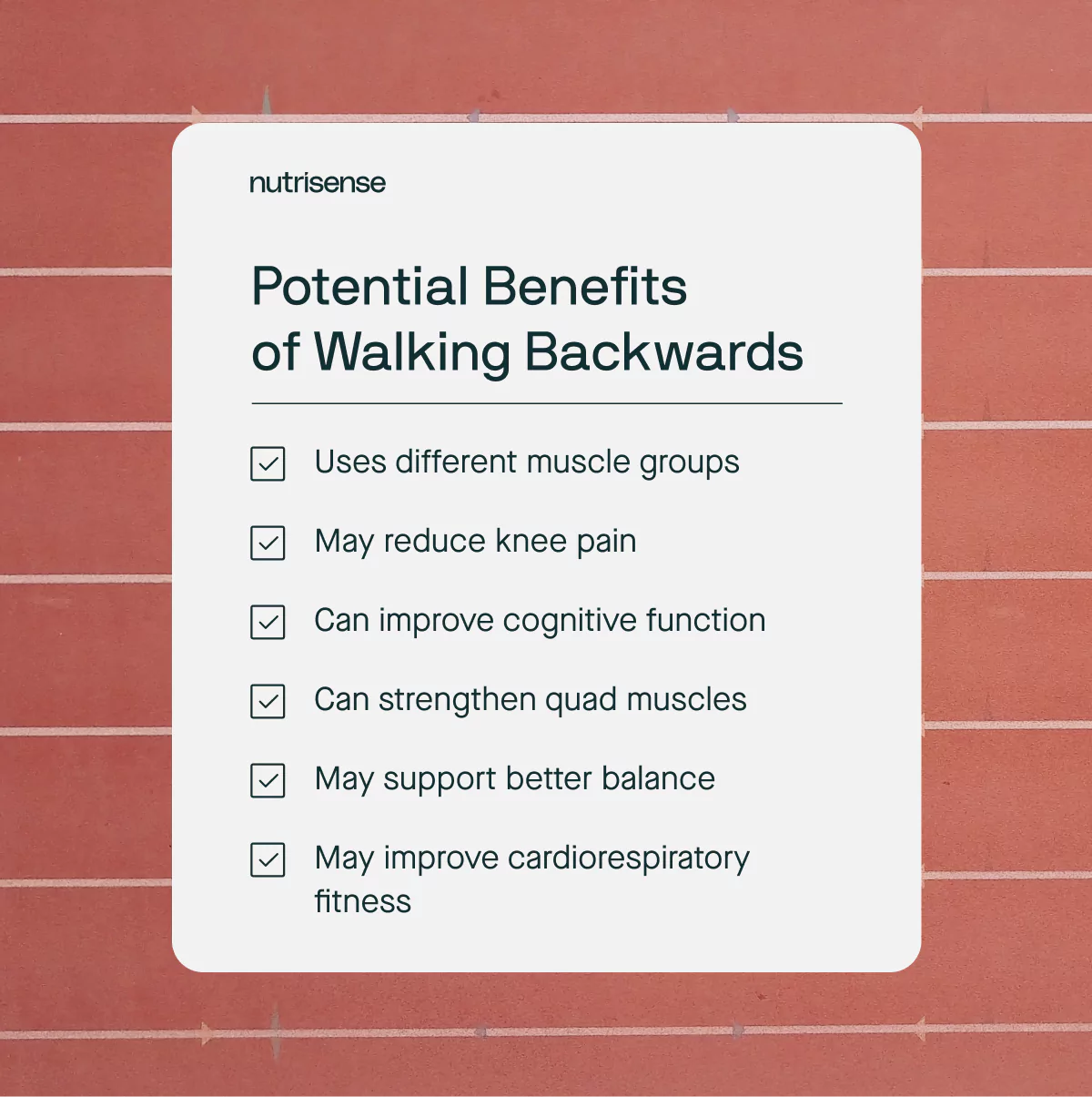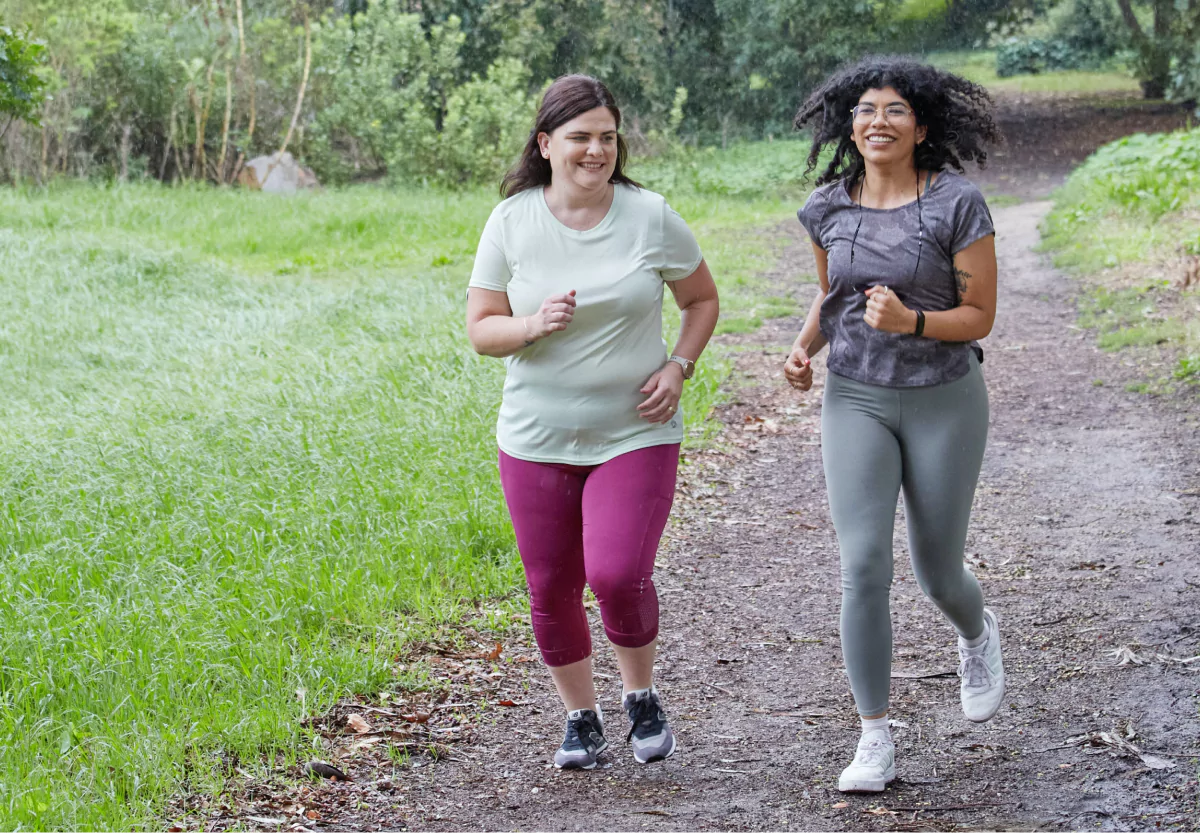6 Benefits of Walking Backwards for Your Health

Key Takeways
For years, backward walking has been a widely used technique among athletes and other populations, with many people arguing that its benefits greatly outweigh the benefits of regular, forward walking. With its recent trendiness on social media platforms like TikTok, many people may be wondering how beneficial backward walking really is and why.
While research has yet to prove exactly how much more beneficial backward walking may be compared to walking forward, current studies do suggest that backward walking has a plethora of potential health benefits. So, let's flip the script and talk about six key ways backward walking might help support healthy aging and mobility.
How Walking Backwards Can Support Healthy Aging

Backward walking is an interesting technique that many physical therapists use with patients recovering from illness or injury. Not only that, some endurance runners even use backward walking as a way to strengthen various muscles in the legs and improve balance.
Overall, the backward walking method may cause a significant regaining range of motion and improving mobility, among several other outcomes. Let's walk through six of the main health benefits of walking backward that can help support healthy aging down the road.
Uses Different Muscle Groups
When you’re walking for a long period of time, you’ll likely notice that you can “feel the burn” in multiple areas of your body at the same time. This is because walking works not one or two but a wide range of muscles in the body. Like forward walking, backward walking also works various leg muscles throughout the body – including some that aren’t utilized as often with forward walking.
For example, a study conducted on trained male athletes looked at the effects of backward running after a five-week period. The group of athletes who trained using the backward walking method saw significant improvements in their frontward running speed without seeing any negative changes to their actual body composition.
May Reduce Knee Pain

Another benefit of walking backward is that it may help reduce knee pain by improving mobility. A study conducted by the Journal of Healthcare Engineering found backward walking to be a helpful strategy for reducing mild to moderate knee pain in otherwise healthy individuals.
At the same time, a study conducted on a group of people with knee osteoarthritis also found that backward walking may help reduce knee pain. This study found that backward walking combined with conventional treatment methods was a more effective course of action than conventional treatment alone. Therefore, backward walking may be a useful method to supplement traditional knee pain treatment regimens.
Can Improve Cognitive Function
Walking backward may also have benefits to overall cognitive function. For most people, forward walking doesn’t require too much thought since we do it every day. However, backward walking forces you to pay closer attention to your body movements and may help increase body awareness. In turn, this may help improve focus and overall body consciousness.
One 2022 study looked at the effects of backward walking on patients with Parkinson's disease. Researchers saw a greater improvement in cognitive function in the group who engaged in backward walking as opposed to the control group. However, researchers also found that age was a major factor in determining cognitive function, as cognitive abilities tend to decrease as we get older.
Strengthen Quadriceps Muscle

Another benefit of walking backward is that it may help strengthen your quadriceps muscle–or your quads. Located at the front of the thigh, the quadriceps muscle is essential for full physical recovery and mobility of the legs and knees.
One study found that after six weeks of establishing a backward walking exercise routine, participants saw a massive improvement in quadriceps muscle strength. On top of this, the backward walking participants reported a significant reduction in both functional disability and pain intensity. This suggests that backward walking may be a suitable low-intensity workout for building leg strength for certain populations.
May Support Better Balance
Backward walking may also support better balance, especially for those recovering from an illness or injury. A 2016 study found that engaging in backward walking can have more positive effects on mobility and balance compared to regular, forward walking. Researchers also found a significant improvement in gait–or one’s natural walking pattern.
Another study looked at the therapeutic effects of walking backward for patients recovering from a stroke. After one month, stroke patients saw significant improvements in their overall balance compared to the control group who did not engage in backward walking.
May Improve Cardiorespiratory Fitness

Cardiorespiratory health is essential, as both the heart and the lungs work together to ensure that enough oxygen-rich blood is produced to keep the body functioning properly. Walking is a well-known way to get in more cardio, so it should be no surprise that backward walking may have a similar benefit for cardiorespiratory health.
When it comes to backward walking, this form of cardio may be particularly beneficial because it may require more energy than forward walking. In this study, researchers found that backward walking was a beneficial way of maintaining or even improving cardiorespiratory health, specifically for patients undergoing rehabilitation.
Is Walking Backward More Beneficial Than Forward Walking?

So, are there really more potential health benefits to backward walking than regular walking? Unfortunately, there is currently minimal research indicating how much more beneficial the effects of backward walking can be.
However, the available research does suggest that backward walking can be more beneficial when it comes to reducing pressure on the joints. Some research observed that backward walking greatly reduced knee and joint pain, as well as improved balance ability, as opposed to forward walking.
Other research suggests that walking backward may lead to a higher energy expenditure, or more calories burned, than forward walking. And of course when it comes to normal walking, there’s plenty of research behind the many health benefits it can have.
Going out for regular walks or establishing a consistent and healthy training program that includes walking may lead to several different positive health outcomes such as:
- Reducing your risk of heart-related conditions
- Improving mental health
- Helping to manage stress levels
- Supporting a better sleep schedule
- Reducing the risk of strokes
Can Backwards Walking Benefit Certain Health Conditions?

Because it's a relatively low-impact activity, backward walking is often used in physical therapy to help patients recover from illness or injury. Researchers have studied the effects of backward walking as a treatment for conditions such as:
- Stroke
- Parkinson’s
- Knee Osteoarthritis
- Multiple Sclerosis
- General rehab for spinal injuries
- General rehab for lower extremity injury
Safety Precautions When Walking Backwards
Unlike regular walking, backward walking can be unsafe if done incorrectly, especially for those who are injured and/or older adults. Without taking the proper precautionary measures, you may run the risk of falling and hurting yourself.
For this reason, it's always best to consult with a healthcare professional before attempting to start backward walking on your own. You’ll want to make sure to start out with a slow speed and try out backward walking on a treadmill while holding onto the handrails.
Seek guidance from a physical therapist or personal trainer to determine if backward walking is right for you and your health goals. Although backward walking can be greatly beneficial in improving different health factors, it's essential that you take great care and caution when doing it.
How to Get Started with Backward Walking
Backward walking is best completed on a treadmill with professional supervision. Before hopping on, be sure that you understand how to safely engage in the backward walking exercise–and make sure you’re wearing comfortable, supportive shoes. Here’s how to get started with backward walking:

- Start out by facing the back of the treadmill with both feet on either side of the belt
- Attach the treadmill’s safety cord to your clothing, which will automatically turn the treadmill off if you move too far away
- Start the treadmill at a very low speed – around one mph
- Start slowly walking backwards while holding onto the hand rails
- Focus on your walking pattern to ensure each foot is stepping backward in a toe-to-heel motion
- Once comfortable, increase the speed gradually
- As you finish, decrease the speed back down to the lowest setting
- When complete, turn off the treadmill and continue walking backward until the treadmill comes to a complete stop
Beginning and finishing your workout with the lowest speed gives your body the “warm up” and “cool down” it needs to prevent harm or further injury. Once you’ve become well-acquainted with backward walking and want to challenge yourself with a new form of exercise, slowly start adding an incline to your workouts and see how it goes!
How Much Reverse Walking Per Day Should You Do?

Given the minimal research done currently on reverse walking, there is no exact amount of time that is recommended for engaging in backward walking. However, the American Heart Association recommends getting in around 150 minutes of moderate physical activity per week–which translates to just over 20 minutes per day.
When engaging in any new physical activity, it’s important that you start slow (10 to 15 minutes) and build your way up to longer, higher-intensity workouts. Once you have some practice under your belt, you can start increasing your walking speed and adding more time onto your workout.
Remember to always consult with a doctor or physical therapist to determine how backward working can work for you.
Find the right Nutrisense programto turn insight into progress.
Go Beyond Glucose Data with Nutrisense
Your glucose can significantly impact how your body feels and functions. That’s why stable levels are an important factor in supporting overall wellbeing. But viewing glucose isn't enough. Nutrisense, you’ll be able to learn how to use your body's data to make informed lifestyle choices that support healthy living.
One-to-one coaching
Sign up to access insurance-covered video calls to work with a glucose expert: a personal registered dietitian or certified nutritionist who will help tailor your lifestyle and diet to your goals.
Monitor and measure what matters
With the Nutrisense CGM Program, you can monitor your glucose with health tech like glucose biosensors and continuous glucose monitor (CGM)s, and analyze the trends over time with the Nutrisense App. This will help you make the most informed choices about the foods you consume and their impact on your health.
Find your best fit
Ready to take the first step? Start with our quiz to find the right Nutrisense program to help you take control.

Heather is a Registered and Licensed Dietitian Nutritionist (RDN, LDN), subject matter expert, and technical writer, with a master's degree in nutrition science from Bastyr University. She has a specialty in neuroendocrinology and has been working in the field of nutrition—including nutrition research, education, medical writing, and clinical integrative and functional nutrition—for over 15 years.




